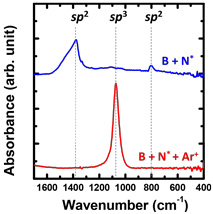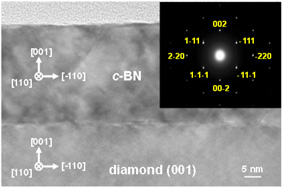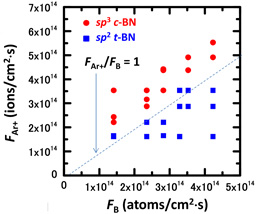Ion-Irradiation Effect in Ion-beam-assisted MBE Growth of c-BN Films
Cubic boron nitride (c-BN) with sp3-bonding has a large bandgap energy of 6.25 eV, which may further expand the potential of nitride-based semiconductor devices. However, conventional growth methods for group-III nitrides, such as MOVPE, have been unsuccessful in the epitaxial growth of c-BN films because c-BN is a metastable phase in ambient atmosphere and a thermodynamically stable sp2-bonded BN phase is easily formed. Recently, we achieved the epitaxial growth of c-BN films by the ion-beam-assisted molecular beam epitaxy (MBE) method, in which boron atoms are supplied by electron-beam evaporation with a simultaneous irradiation of N2+ and Ar+ [1]. Here we establish the growth phase diagram for c-BN thin-film growth and show that the flux intensity ratio of Ar+ to boron (FAr+/FB) is a key to controlling the crystal structures of BN films.
BN films were grown on diamond(001) substrates by electron-beam evaporation of boron with a simultaneous supply of nitrogen radical (N*) and Ar+. Instead of N2+, N* was used a nitrogen source to investigate the proper ion-irradiation condition of Ar+ for c-BN growth. The V/III ratio, defined as the flux intensity ratio of N* to boron (FN*/FB), was set at values > 1. The growth temperature (Tg) was 920°C.
Figure 1 shows FT-IR absorption spectra of BN films with and without Ar+ irradiation. Without Ar+ irradiation, absorption peaks attributed to BN sp2-bonding were observed at around 780 and 1380 cm-1. On the other hand, with Ar+ irradiation (FAr+/FB>1), only an FT-IR absorption peak attributed to BN sp3-bonding was observed at around 1070 cm-1. Other peaks originating from BN sp2-bonding were not observed. From a cross-sectional TEM image and the selective-area electron diffraction (SAED) pattern, we confirmed that the c-BN(001) film was epitaxially grown on the diamond(001) substrate from the initial growth stage (Fig. 2). Accordingly, the Ar+ irradiation is a prerequisite for the selective formation of the sp3-bonded c-BN.
Next, we focused on the effect of FAr+ on the structure of BN films. We carried out regrowth of BN films on c-BN(001) film templates on diamond substrates; FAr+ and FB were systematically varied. Figure 3 shows the growth phase diagram plotted as functions of FAr+ and FB. The c-BN(001) films are epitaxially grown at FAr+/FB larger than 1, while sp2-bonded turbostratic BN (t-BN) films are grown at FAr+/FB smaller than 1 even on the c-BN(001) templates. Thus, FAr+/FB larger than 1 is necessary for epitaxial growth of c-BN films, in addition to V/III larger than 1 and Tg above 750°C [1].
This work was supported by KAKENHI.
- [1] K. Hirama et al., Appl. Phys. Lett. 104, 092113 (2014).

|

|

|
| Fig. 1. FT-IR spectra of BN films grown with and without Ar+ irradiation. | Fig. 2. Cross-sectional TEM image and SAED pattern of epitaxial c-BN(001) film. | Fig. 3. Growth phase diagram for BN as functions of FAr+ and FB. |